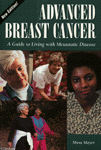Advanced Breast Cancer: A Guide for Living with Metastatic Disease
Author: Musa Mayer |
According to Musa Mayer, there are two groups of breast cancer patients: those with primary cancer of the breast, hoping for a cure, and those with metastatic disease, defined as the spread of cancer from one part of the body to another. This book is written for the second group. The lack of available information for women with advanced breast cancer is what motivated this breast cancer survivor to put down on paper the experiences of thirty-two people living with the realities of metastatic disease. Ms. Mayer is known for her previous work, "Examining Myself: One Woman's Story of Breast Cancer Treatment and Recovery." Both books are based on her stated belief that knowing about and reading what other people have experienced will be of help practically and emotionally.
The length of survival for metastatic breast cancer can be remarkably variable. Through the stories of ordinary women and their families the author attempts to answer the question how does one "live"day by day with the knowledge of metastatic breast cancer? How do people balance on "the thin edge between preserving hope and facing reality, between optimism and truth telling and between challenge and acceptance?" Mayer answers these complex questions, allaying anxiety somewhat with just the right amount of pragmatic information interspersed with real life experiences.
Some of the topics covered include definitions of medical terms such as local recurrence, regional and distant recurrence, bone and liver metastasis and the risks and benefits of researching your own disease. A general review of treatments and choices for metastatic disease leads to the fundamental necessity of clarifying your own and your physician's treatment philosophy concerning palliation, controlling the spread, relieving symptoms, versus aggressive treatment aimed at a chance of extended remission or even cure. Complementary therapies are discussed, and the distinction between them and alternative therapies. The chapter entitled "Living with Side Effects and Symptoms" is focused on the experience and concern most poeple have about continuing their roles, rather than information about the clinical management of symptoms such as pain and fatigue. Another chapter entitled "Families and Friends Speak" examines the mixed emotions, typical conflicts, and stigma of cancer for patients and their loved ones including partners, children, extended family, and friends. The most difficult but very important last chapters on remission, disease progression and final days include many moving and inspiring insights that will no doubt be extremely meaningful to those facing this disease.


